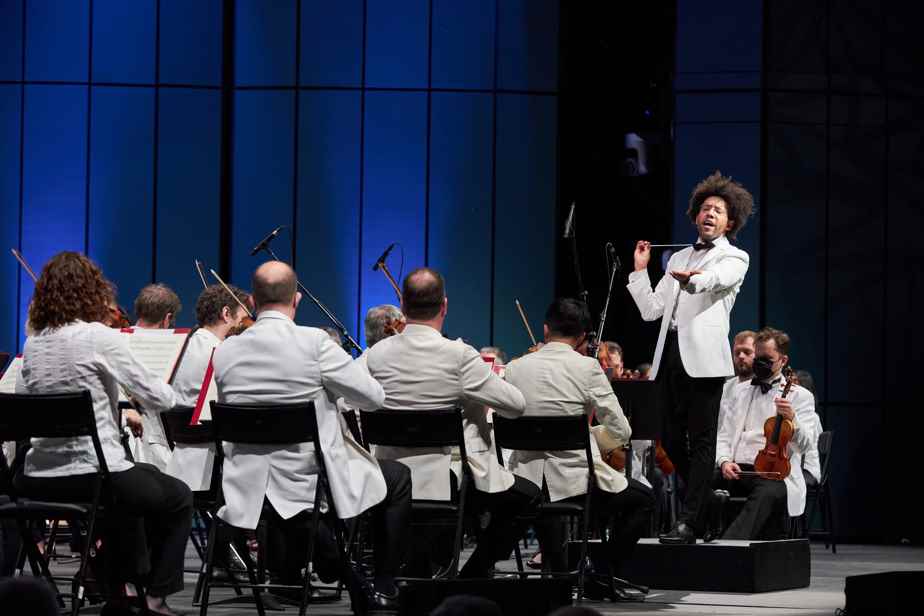It was the opening, Thursday evening, of the first “full speed” Lanaudière Festival since 2019. The Orchester symphonique de Montréal and its conductor Rafael Payare occupied the stage of the Fernand-Lindsay amphitheater in a program that they will give again next week on a South Korean tour.
Posted at 3:10 p.m.
Artistic director Renaud Loranger wisely recalled before the start of the concert that the new conductor of the OSM had performed in Lanaudière with the orchestra on July 27, 2019, an evening that he was pleased to think of as decisive in the selection process for Kent Nagano’s successor.
The latter had closed the last pre-pandemic festival with the Third symphony by Mahler. It was he who picked up the slack last year with the Fourth Symphony by the same composer, Payare not having been able to free himself for the occasion. Logical continuation, it is the fifth symphony which was on the menu to open the 2022 edition, with a Violin Concerto No. 1 by Prokofiev featuring the great Hilary Hahn as an appetizer.
A well-rehearsed Mahler symphony in anticipation of a tour by one of the best orchestras in North America with a passionate conductor, all in a festival setting, could you ask for better? This is to forget that Mahlerian alchemy is a difficult art that few manage to dose satisfactorily. Because this music, perhaps more than many others, is above all a matter of atmosphere.
First observation: a lack of obvious contrasts between the first and second movements. For the first movement, Mahler specifies: “Funeral march. With a measured, severe step. Like a funeral procession. So we expect to have something afflicted and posed.
After the famous trumpet call at the start, played with a broad, brassy sound by Paul Merkelo, Rafael Payare embarks on a mad dash, where Mahler multiplies the “ponde” and “schwer” (heavy). The lyrical string theme following the opening episode is therefore somewhat indifferently led and not “a little restrained”.
When the second movement arrives, indicated “stormily agitated, with the greatest vehemence”, we hardly feel any difference in climate, especially since the conductor does not come out of his hinges enough. The second cello theme is nevertheless realized with a remarkable art of singing.

PHOTO ANNIE BIGRAS, PROVIDED BY THE FESTIVAL DE LANAUDIÈRE
The great violinist Hilary Hahn performed the Violin Concerto No. 1 by Prokofiev.
The third movement is perhaps the most difficult to render given its variegated character. Under Payare’s baton, it is difficult to feel the unity of this quilt, the common thread that runs through this scherzo of almost 20 minutes. The first theme, where Mahler writes “not too quickly”, simply lacks bonhomie.
Then comes the famous Adagietto which, under its apparent simplicity, hides several pitfalls. The “good” tempo obviously does not exist here, especially since the composer calls the movement “a little slow”… while specifying “very slow” in German just below. Bruno Walter seduces as much by doing it in 8 minutes as Bernard Haitink by stretching it to 14 minutes. What matters is to nourish the sound, to “fill” the space with the legato.
But Payare hardly convinces here, especially since the “molto ritardando” required in the ineffable first entry of the violins is not really respected. The idea of making the return of the main theme at the end softer and slower than the beginning was, however, rather interesting.
The Finale, which the conductor directs all at once, was his best moment, in particular considering the prohibitive length and heterogeneity of this movement.
And the Prokofiev in all this? It is to Hilary Hahn’s credit that she plays this concerto without listening too much to herself, as too many of her colleagues do. She is having fun like crazy in the roller coaster of this score and it becomes infectious. However, we would have taken a few more doses of acid, both in the violin and in the orchestra, which would have benefited from taking up a little more space and emphasizing the “marcato” passages more.
